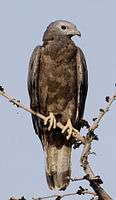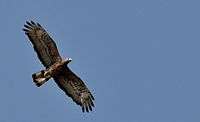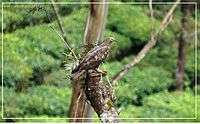Crested honey buzzard
| Crested honey buzzard | |
|---|---|
_Photograph_By_Shantanu_Kuveskar.jpg) | |
| Scientific classification | |
| Kingdom: | Animalia |
| Phylum: | Chordata |
| Class: | Aves |
| Order: | Accipitriformes |
| Family: | Accipitridae |
| Genus: | Pernis |
| Species: | P. ptilorhynchus |
| Binomial name | |
| Pernis ptilorhynchus (Temminck, 1821) | |
| Synonyms | |
| |
The crested honey buzzard (Pernis ptilorhynchus)[3] is a bird of prey in the family Accipitridae which also includes many other diurnal raptors such as kites, eagles and harriers. This species is also known as the Oriental honey buzzard.
Description

Despite its name, this species is not related to Buteo buzzards, and is taxonomically closer to the kites.[4] It appears long-necked with a small head (resembling that of a pigeon), and soars on flat wings. The head lacks a strong superciliary ridge giving it a very un-raptor-like facial appearance. It has a long tail and a short head crest. It is brown above, but not as dark as European honey buzzard, and paler below. There is a dark throat stripe. Unusually for a large bird of prey, the sexes can be distinguished. The male has a blue-grey head, while the female's head is brown. She is slightly larger and darker than the male. The male has a black tail with a white band, whilst the female resembles female honey-buzzard.
It breeds in Asia from central Siberia east to Japan. It is a summer migrant to Siberia, wintering in tropical south east Asia. Elsewhere it is more-or-less resident. It is a specialist feeder, living mainly on the larvae of social bees and wasps, also eating bits of comb and honey;[5] it will take other small insect prey such as cicadas.[6]
The Crested honey buzzard breeds in woodland, and is inconspicuous except in the spring, when the mating display includes wing-clapping. The display of roller-coasting in flight and fluttering wings at the peak of the ascent are characteristic of the genus Pernis.[7][8]
It is larger and longer winged than its western counterpart, the European honey buzzard, Pernis apivorus.
Mimicry
It has been suggested that the similarity in plumage between juvenile Crested honey buzzard and the Spizaetus hawk-eagles has arisen as a partial protection against predation by larger raptors. The eagles have stronger bills and talons, and are likely to be less vulnerable than the Pernis species.
Similar mimicry is shown by the juveniles of the European honey buzzard, which resembles the common buzzard. Although the northern goshawk is capable of killing both species, it is likely to be more cautious about attacking the better protected Buteo species.
Gallery
 Oriental honey-buzzard Pernis ptilorhynchus
Oriental honey-buzzard Pernis ptilorhynchus-_Bharatpur_I2_IMG_8242.jpg) Female?
Female? In flight
In flight With honey comb
With honey comb
References
- ↑ BirdLife International (2004). "Pernis ptilorhynchus". IUCN Red List of Threatened Species. Version 2006. International Union for Conservation of Nature. Retrieved 28 Jan 2008. Database entry includes justification for why the species is of least concern
- ↑ Dickinson, Edward C. (2012). "The first twenty livraisons of Les Planches Coloriées d'Oiseaux of Temminck & Laugier (1820–1839): IV. Discovery of the remaining wrappers." (PDF). Zoological Bibliography. 2 (1): 34–49.
- ↑ "Pernis ptilorhynchus (Crested Honey Buzzard)". Integrated Taxonomic Information System. Retrieved 15 May 2016.
- ↑ Finlayson, Clive (2011). Avian Survivors: The History and Biogeography of Palearctic Birds. London, UK: T & AD Poyser. pp. 121–132. ISBN 978-0-7136-8865-8.
- ↑ http://www.hbw.com/species/oriental-honey-buzzard-pernis-ptilorhynchus
- ↑ Brues, Charles T. (1950). "Large Raptorial Birds as Enemies of Cicadas" (PDF). Psyche. 57 (2): 74–76. doi:10.1155/1950/49542.
- ↑ James Ferguson-Lees; David A. Christie; Kim Franklin; Philip Burton; David Mead (2001). Raptors of the World: An Identification Guide to the Birds of Prey of the World. HMCo Field Guides. ISBN 0-618-12762-3.
- ↑ Gewers, G.; Curio, E.; Hembra, S H (2006). "First observation of an advertisement display flight of 'Steere's Honey-buzzard' Pernis (celebensis) steerei on Panay, Philippines" (PDF). Forktail. 22: 163–165.
External links
| Wikimedia Commons has media related to Pernis ptilorhyncus. |
